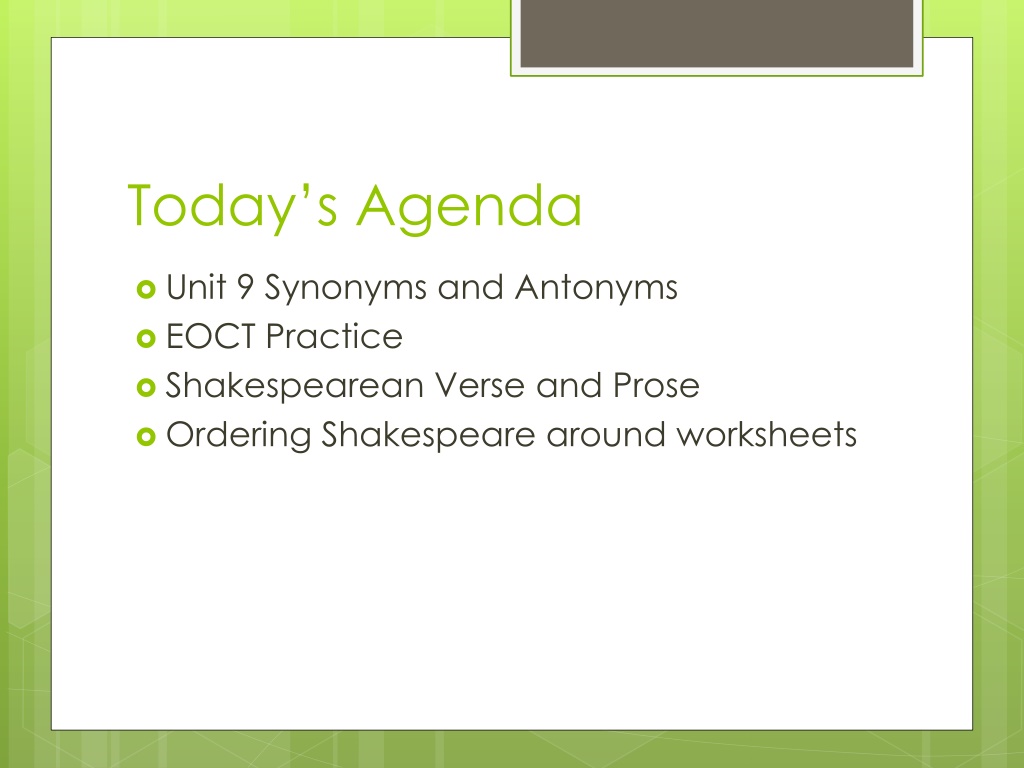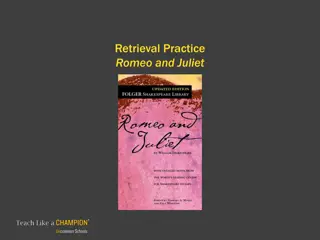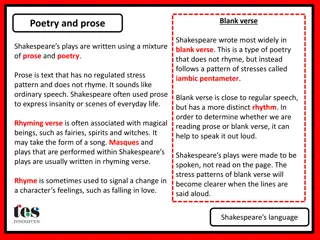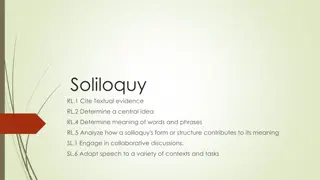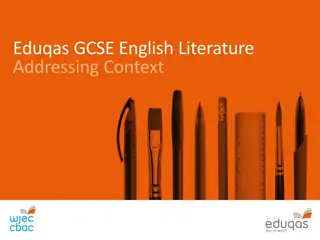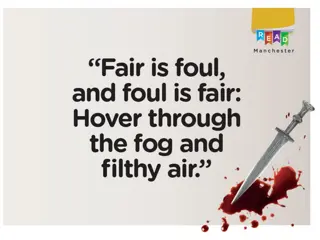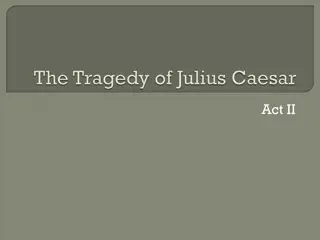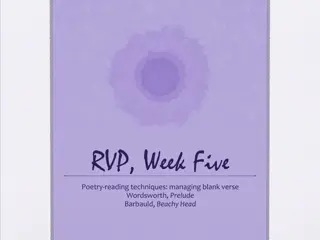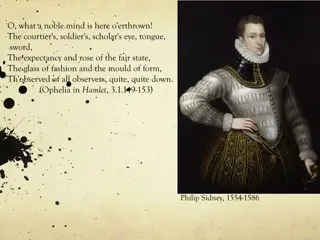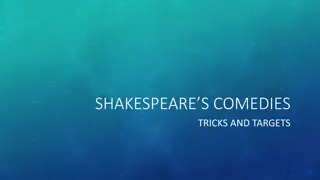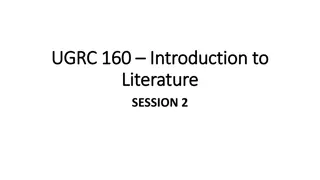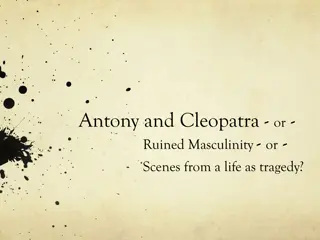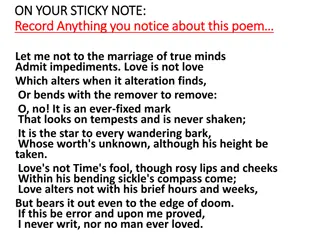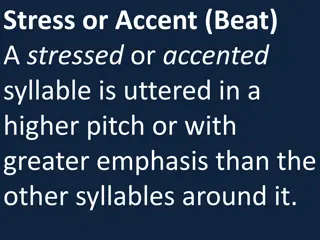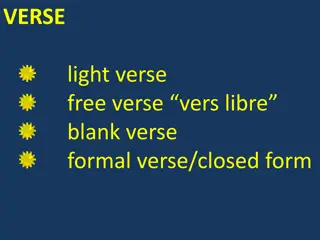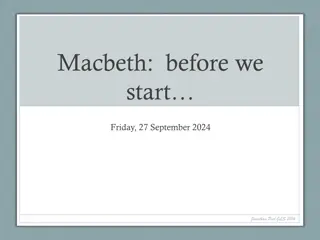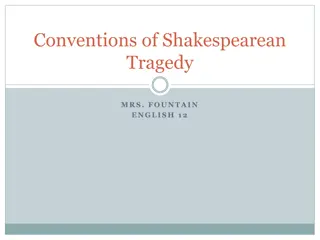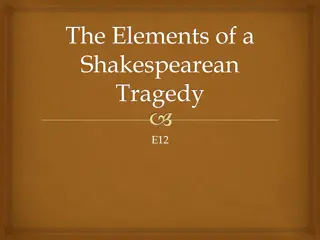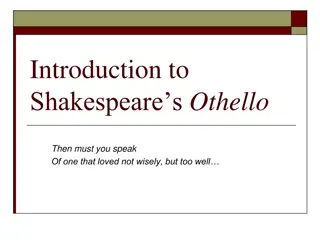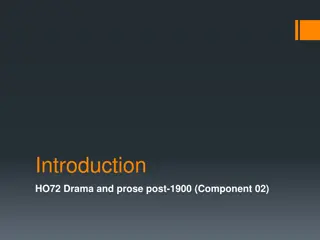Understanding Shakespearean Verse and Prose: A Comprehensive Guide
Delve into the intricate world of Shakespeare's language with a focus on prose, rhymed verse, and blank verse. Learn how to distinguish between these forms and their significance in his plays through visual and textual clues. Explore examples of rhymed couplets and heroic couplets, shedding light on their thematic importance.
Download Presentation

Please find below an Image/Link to download the presentation.
The content on the website is provided AS IS for your information and personal use only. It may not be sold, licensed, or shared on other websites without obtaining consent from the author. Download presentation by click this link. If you encounter any issues during the download, it is possible that the publisher has removed the file from their server.
E N D
Presentation Transcript
Todays Agenda Unit 9 Synonyms and Antonyms EOCT Practice Shakespearean Verse and Prose Ordering Shakespeare around worksheets
Shakespearean Verse and Prose The language used by Shakespeare in his plays is in one of three forms: prose, rhymed verse or blank verse
Prose refers to ordinary speech with no regular pattern of accentual rhythm Lines of text do not all have the same number of syllables nor is there any discernible pattern of stresses
If you are unsure if a passage is in prose or in blank verse, look for the following visual clue: a long passage in prose is typically printed in your text like an ordinary paragraph Standard rules of capitalization are followed: only proper nouns (names and place names), the pronoun "I" and the first letter of a new sentence are capitalized.
Shakespeares use PROSE is used whenever verse would seem bizarre Examples: in serious letters (Macbeth to Lady Macbeth; Hamlet to Horatio), in proclamations, and in the speeches of characters actually or pretending to be mad Prose is used for cynical commentary
Rhymed verse Shakespeare's plays is usually in rhymed couplets, i.e. two successive lines of verse of which the final words rhyme with another. The rhyme pattern of verse in rhyming couplets is conventionally represented: aa bb cc
Example: Helena's lament in A Midsummer Night's Dream (I.i.234-9): Love looks not with the eyes, but with the mind; ("a" rhyme) And therefore is winged Cupid painted blind. ("a" rhyme) Nor hath Love's mind of any judgment taste; ("b" rhyme) Wings, and no eyes, figure unheedy haste: ("b" rhyme) And therefore is Love said to be a child, ("c" rhyme) Because in choice he is so oft beguiled. ("c" rhyme) When two lines of rhyming couplets are in iambic pentameter (like the above passage), they are called heroic couplets
Shakespeares use often used for ritualistic or choral effects and for highly lyrical or sententious passages that give advice or point to a moral It is also used for many manifestations of the supernatural (e.g. the witches in Macbeth; the fairies in A Midsummer Night's Dream
Blank Verse refers to unrhymed iambic pentameter Blank verse resembles prose in that the final words of the lines do not rhyme in any regular pattern, but there is a recognizable meter
Shakespeares Use employed in a wide range of situations because it comes close to the natural speaking rhythms of English but raises it above the ordinary without sounding artificial used mainly for passionate, lofty or momentous occasions and for introspection; it may suggest a refinement of character Many of Shakespeare's most famous speeches are written in blank verse
Iambs A particular type of meter consisting of an unstressed syllable followed by a stressed syllable (da DUM) an iamb is conventionally represented U / .
Iambic Pentameter A ten-syllable line consisting of five iambs Its stress pattern (five pairs of unstressed/stressed syllables)
Example The course of true love never did run true As you read this line aloud, listen for the stress pattern: da DUM da DUM da DUM da DUM da DUM the COURSE of TRUE love NEver DID run TRUE
wherefore for what reason: for what reason or purpose
Exeunt exit from stage: used as a stage direction in a text in place of "exit" when more than one actor is to leave the stage
Vulgar characterized by ignorance of or lack of good breeding or taste
Construe interpret something in particular way: to interpret or understand the meaning of a word, gesture, or action in a particular way
Tragedy a form of drama based on human suffering that invokes in its audience an accompanying catharsis or pleasure in the viewing
Pun a form of word play which suggests two or more meanings
Conflict difference: a disagreement or clash between ideas, principles, or people Internal Conflict: Man vs. Self External Conflict: Man vs. Man Man vs. Nature Man vs. Society
Soliloquy a device often used in drama when a character speaks to oneself, relating thoughts and feelings the act of speaking while alone
Shakespearean Syntax (Word Order): Four words can create six unique sentences which carry the same meaning. When you are reading Shakespeare, look for his unusual word arrangement. Locate the subject verb, and object of the sentence. Notice that the object of the sentence is often placed at the beginning in front of the verb and the subject. This should help with making sense of Shakespeare. Example : Benvolio: So early walking did I see your son. Becomes [did] I [saw ] your son walking [so] early.
I ate the sandwich. I the sandwich ate. Ate the sandwich I. Ate I the sandwich. The sandwich I ate. The sandwich ate I.
